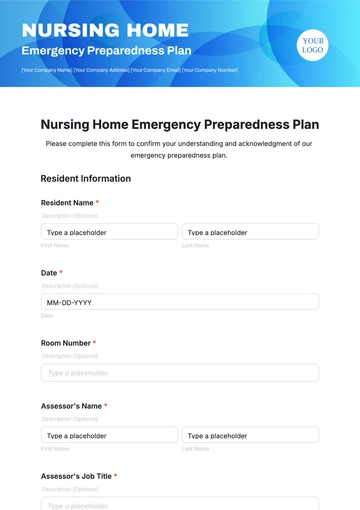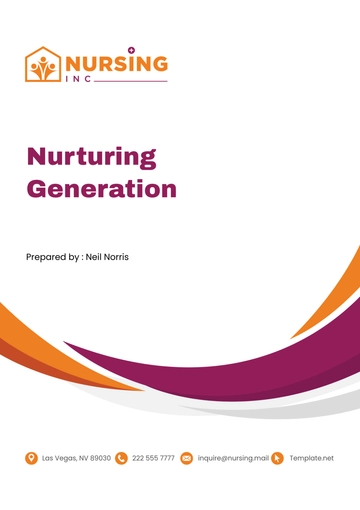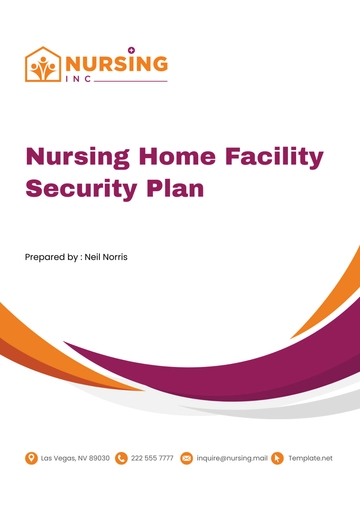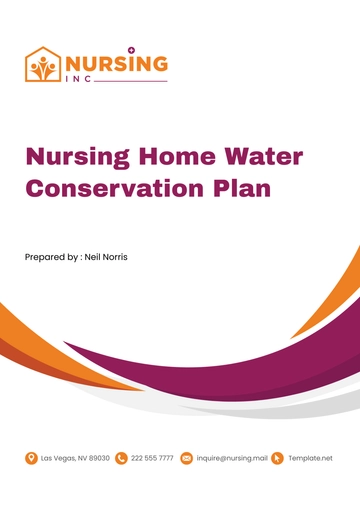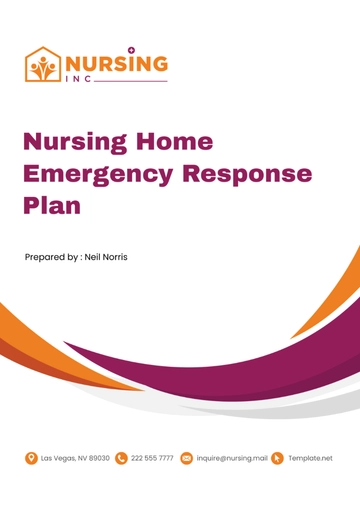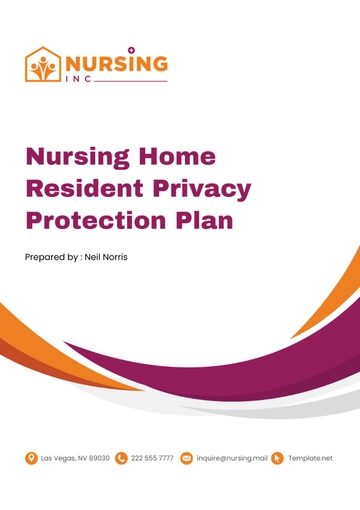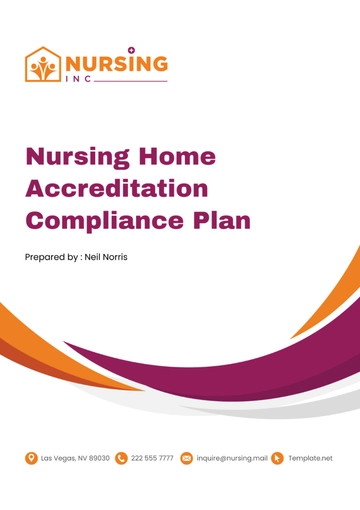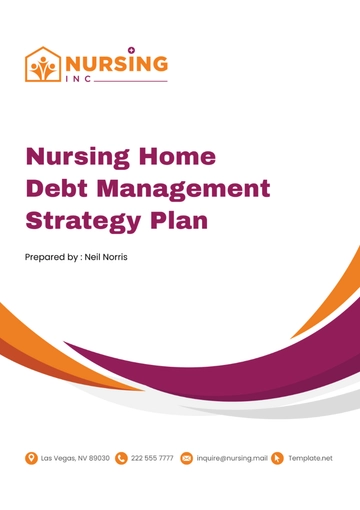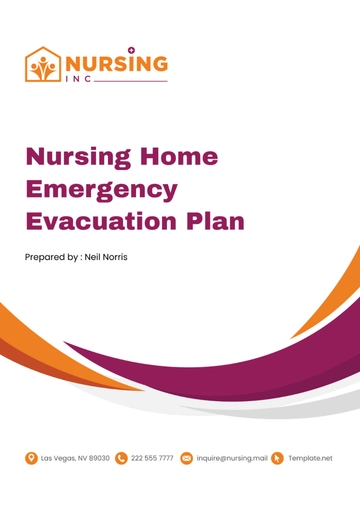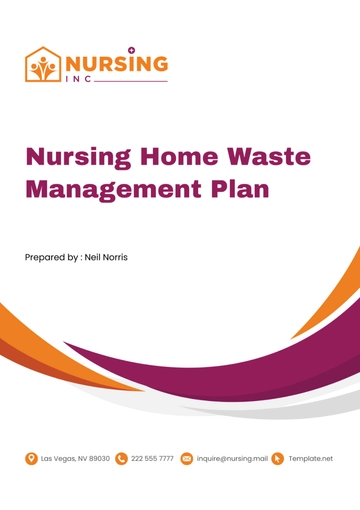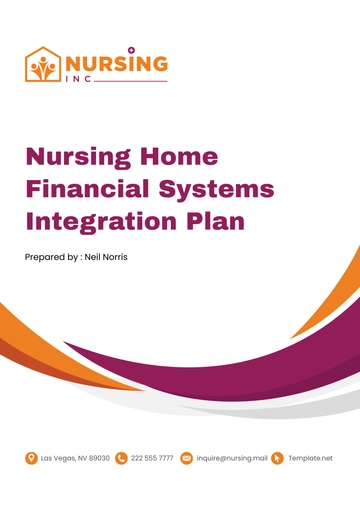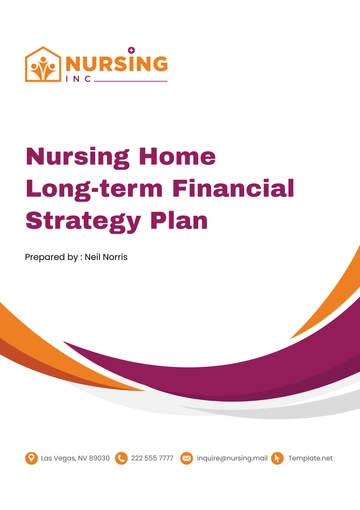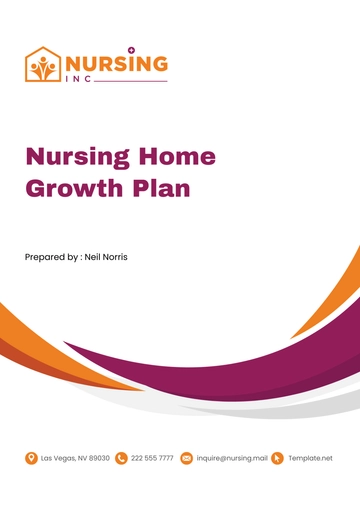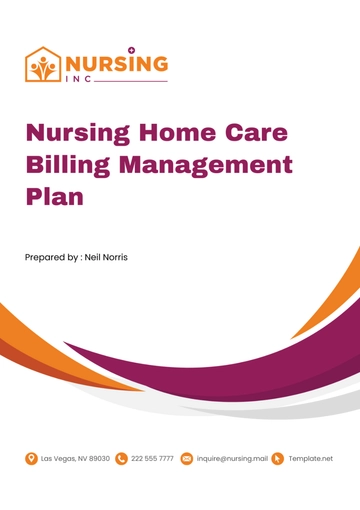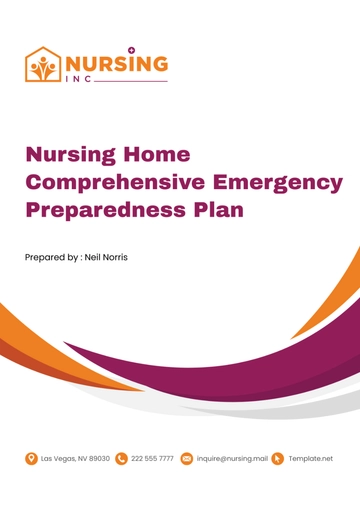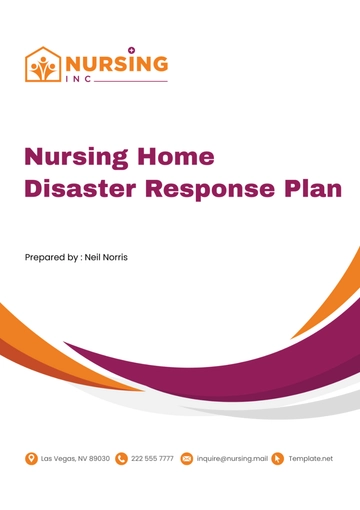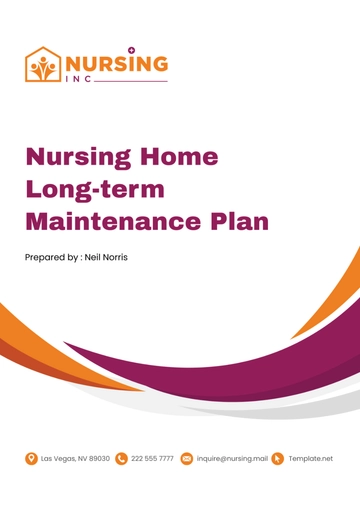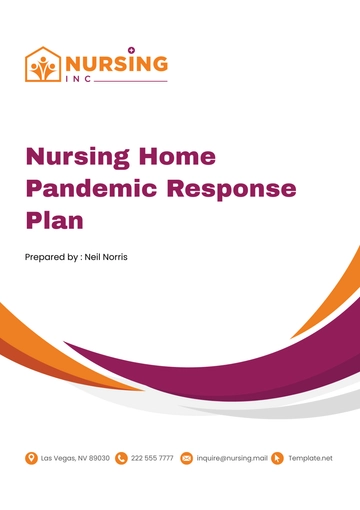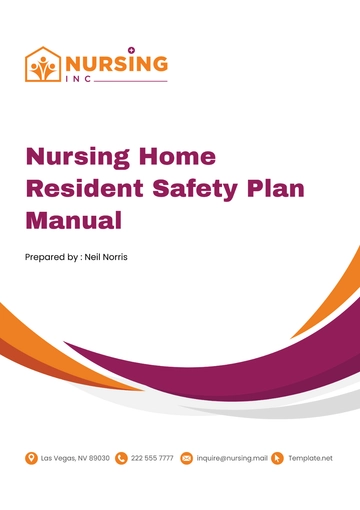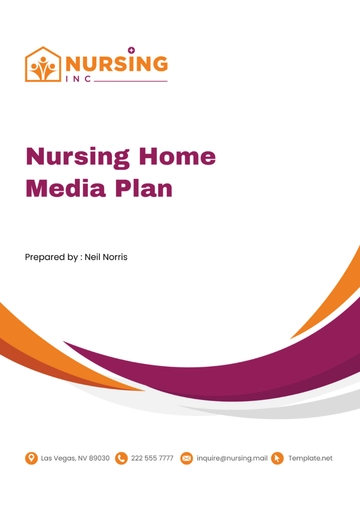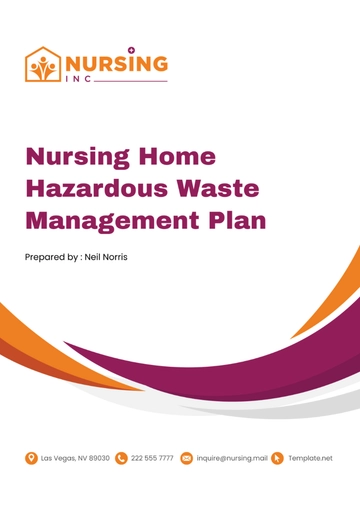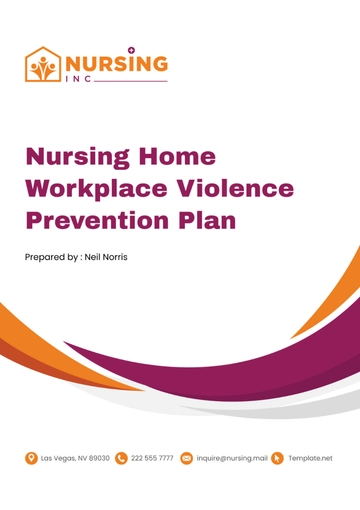Free Nursing Home Long-term Maintenance Plan
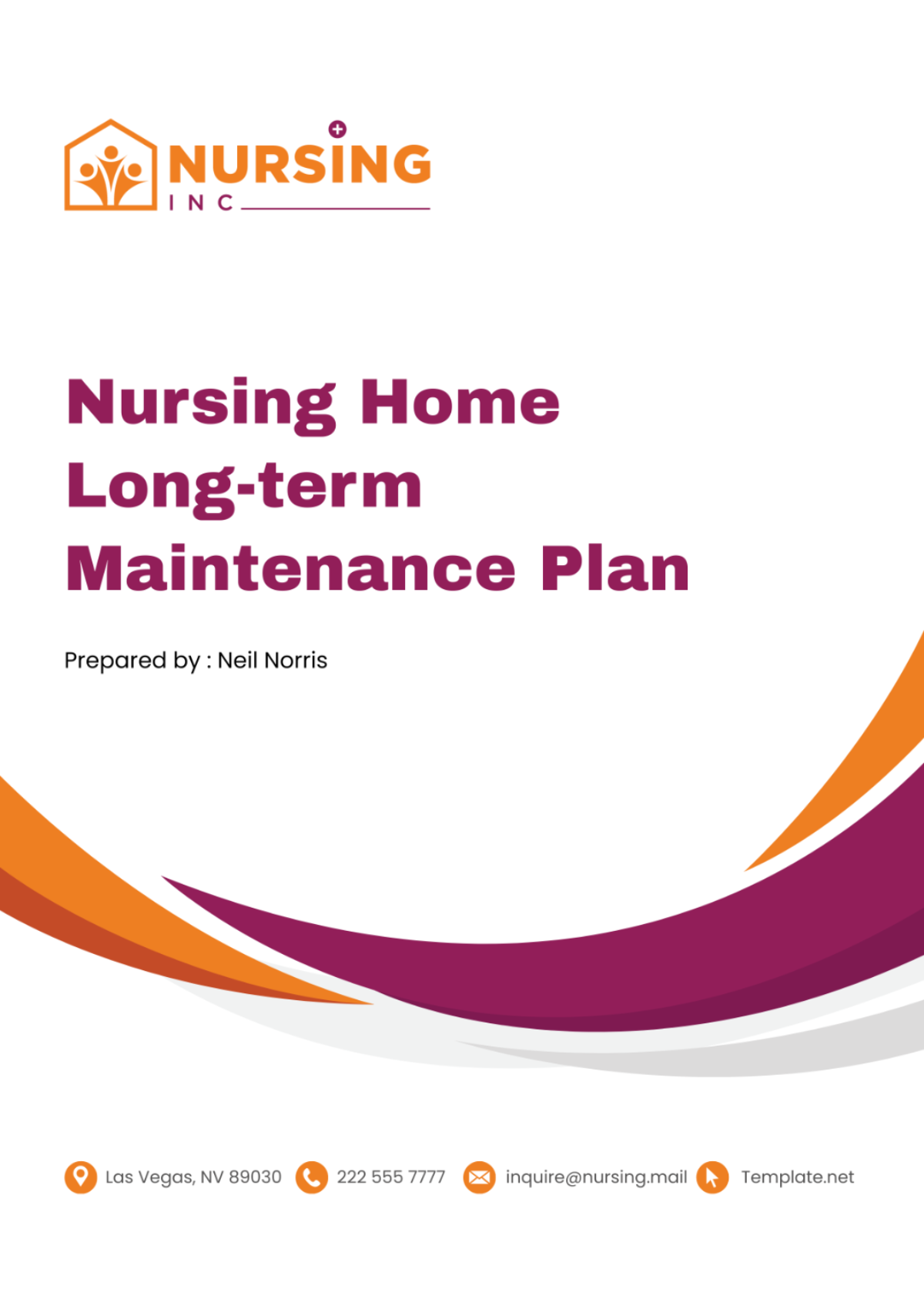
Introduction
This Long-term Maintenance Plan has been meticulously crafted to ensure the continuous operation, safety, and comfort of [Your Company Name]. It outlines a systematic approach to the maintenance and management of our facility's infrastructure, equipment, and environment. This document serves as a guide for the maintenance staff, administration, and stakeholders, detailing preventive measures, schedules, and protocols for the upkeep of the nursing home.
Objectives
The primary objective of this plan is to ensure that all physical assets and operational systems within the nursing home are maintained at the highest possible standards. The plan aims to extend the lifespan of our assets, optimize operational efficiency, and ensure compliance with all relevant health and safety standards.
Methodology
The methodology is grounded in best practices in facility management and maintenance. It employs a proactive approach to maintenance, emphasizing the importance of regular inspections, preventive maintenance schedules, and the prompt addressing of repair needs. The plan is supported by a comprehensive asset inventory and utilizes a digital maintenance management system to track maintenance activities, schedules, and costs.
Facility Overview and Asset Inventory
The Facility Overview and Asset Inventory section of this plan provides a critical foundation for all maintenance and improvement efforts. It systematically catalogs and assesses the state of the facility’s infrastructure, equipment, and systems, ensuring a clear understanding of assets and their maintenance needs.
Comprehensive Asset Cataloging: Every asset within the nursing home, from structural components to medical equipment, is meticulously recorded. This cataloging includes detailed descriptions, current conditions, acquisition dates, and expected lifespans, providing a clear picture of the facility's assets and their maintenance requirements.
Strategic Maintenance Planning: The inventory serves as a basis for developing targeted maintenance schedules and strategies. By understanding the specific needs and conditions of each asset, we can prioritize maintenance tasks, allocate resources more effectively, and prevent potential failures before they occur.
Resource Allocation and Budgeting: A well-documented asset inventory aids in the accurate forecasting of maintenance costs and the efficient allocation of financial and human resources. It ensures that funds are directed toward the most critical maintenance activities, optimizing the use of the nursing home’s budget for facility care.
Regulatory Compliance and Safety: The inventory helps ensure that all equipment and facilities meet the necessary safety and compliance standards. Regular updates and reviews of the asset inventory facilitate adherence to health codes, building regulations, and industry best practices, safeguarding the well-being of our residents and staff.
Asset Category | Asset Description | Location | Acquisition Date |
|---|---|---|---|
Structural | Roofing System | Entire Facility | 2052 |
HVAC | Central Air Conditioning Unit | Main Building | 2050 |
Medical Equipment | Portable Ultrasound Machine | Room 101 | 2054 |
Utility Systems | Electrical Panel | Basement | 2051 |
Safety Equipment | Fire Extinguishers | Various Locations | 2055 |
IT Equipment | Nurse Call System | Entire Facility | 2053 |
Maintenance Schedule:
Asset Category | Last Maintenance Date | Next Scheduled Maintenance | Condition |
|---|---|---|---|
Structural | 2057 | 2058 | Good |
HVAC | 2057 | 2058 | Fair |
Medical Equipment | 2057 | 2058 | Excellent |
Utility Systems | 2057 | 2058 | Good |
Safety Equipment | 2057 | 2058 | Excellent |
IT Equipment | 2057 | 2058 | Good |
The Facility Overview and Asset Inventory is regularly updated to reflect changes in asset conditions, replacements, and new acquisitions. It is instrumental in ensuring the long-term maintenance and enhancement of the nursing home’s facilities, directly contributing to the quality of care and living environment we provide.
Preventive Maintenance Schedule
This schedule is designed to ensure that all equipment and infrastructure undergo regular inspection and maintenance, thereby preventing potential failures and extending asset lifespans. This proactive approach minimizes unexpected repairs, maintains operational efficiency, and upholds our facility’s standards of excellence.
Detailed Maintenance Intervals: Each asset is assigned a specific maintenance interval based on manufacturer recommendations, industry standards, and our historical data on asset performance and usage. This ensures that maintenance activities are performed optimally to prevent premature wear or failure.
Comprehensive Scope of Work: For each scheduled maintenance activity, a detailed scope of work is provided, outlining the specific tasks to be performed, the tools and parts required, and the safety protocols to be followed. This ensures clarity and consistency in maintenance execution.
Staff Assignments and Training: Maintenance tasks are assigned to qualified staff members based on their expertise and training. This includes ongoing education and certification to ensure that our team is equipped with the latest skills and knowledge to maintain our state-of-the-art facility.
Use of Maintenance Management Software: We employ advanced maintenance management software to schedule, track, and document all preventive maintenance activities. This system sends automated reminders to staff, tracks maintenance history, and provides reports on maintenance costs and asset conditions.
Integration with Facility Operations: The preventive maintenance schedule is integrated with the nursing home’s operational calendar to minimize disruptions to residents and staff. Maintenance activities are planned during off-peak hours whenever possible, ensuring a seamless continuation of care and service.
Regular Review and Adjustment: The schedule is reviewed and adjusted regularly based on changes in asset conditions, usage patterns, and technological advancements. This ensures that our maintenance strategies remain effective and responsive to the evolving needs of our facility.
Month | Scheduled Tasks | Assigned Team |
|---|---|---|
January | Inspect and clean filters, check refrigerant levels, test system controls | Facilities Team |
February | Test fire alarms and smoke detectors, inspect fire extinguishers, review evacuation plans | Safety Officer |
March | Calibrate diagnostic machines, inspect and test emergency call systems | Biomedical Engineering Team |
April | Inspect roofing for damage, clean gutters and drains, check foundation for cracks | External Contractors |
May | Test backup generators, inspect electrical wiring, check water systems for leaks | Facilities Team |
June | Landscape maintenance, inspect outdoor lighting and walkways, prepare outdoor areas for resident use | Landscaping Team |
Corrective Maintenance Procedures
This segment delineates the structured approach and methodologies we employ to ensure that corrective maintenance is performed in a way that minimizes impact on residents and operations while maintaining the highest standards of safety and quality. These procedures are designed to ensure rapid response, effective resolution, and thorough documentation of all corrective maintenance activities.
Immediate Issue Identification and Assessment: At the onset of an issue, our first step involves a prompt and thorough assessment to determine the severity, potential impact, and required urgency of the corrective action. This quick assessment allows us to prioritize the maintenance request appropriately and mobilize resources efficiently.
Rapid Mobilization of Maintenance Teams: Once an issue is identified, our maintenance management system automatically notifies the appropriate maintenance personnel based on the type of issue and its location. This system ensures that the right team with the right skills is dispatched quickly to address the problem.
Use of Standardized Repair Protocols: For common and recurrent issues, we have developed standardized repair protocols to ensure consistency and efficiency in corrective actions. These protocols are based on best practices, manufacturer guidelines, and our historical maintenance data, ensuring that repairs are performed to our stringent quality standards.
Safety and Compliance First Approach: In all corrective maintenance activities, the safety of our residents and staff is paramount. We adhere strictly to safety protocols and regulatory compliance standards, using only approved materials and methods in our repairs.
Post-Repair Testing and Verification: After any corrective maintenance task is completed, the repaired asset undergoes rigorous testing to verify that it is fully operational and meets all safety and performance standards.
Documentation and Feedback Loop: All corrective maintenance activities are meticulously documented in our maintenance management system. This documentation includes a detailed report of the issue, the actions taken to resolve it, the personnel involved, and any parts used.
Resident and Staff Communication: Transparent communication with our residents and staff about maintenance issues and their resolution is a key component of our approach. We keep affected parties informed of the issue, expected resolution time, and any necessary precautions or temporary changes in routine.
By following these comprehensive and thoughtful procedures, we ensure that our facility remains a welcoming, safe, and well-maintained home for our residents and a positive, efficient workplace for our staff.
Safety and Compliance Standards
Through meticulous planning, implementation, and continuous review, we ensure that our facility exceeds the necessary local, state, and federal guidelines, thereby fostering a culture of excellence and accountability.
Adherence to Regulatory Frameworks: Our facility rigorously follows the comprehensive array of healthcare, safety, and building codes applicable to nursing home operations. This includes, but is not limited to, OSHA guidelines, ADA requirements, NFPA standards for fire safety, and state-specific health care facility regulations.
Continuous Safety Education: We believe that a well-informed staff is the cornerstone of a safe environment. As such, all employees undergo regular, mandatory training sessions on safety practices, emergency response protocols, and compliance standards.
Proactive Risk Management: Our approach to safety and compliance is inherently proactive. We employ a comprehensive risk management strategy that includes regular facility inspections, hazard assessments, and the implementation of corrective measures to mitigate identified risks before they lead to incidents.
Innovative Safety Technologies: Leveraging the latest in safety technologies, our facility is equipped with advanced systems for fire detection and suppression, security surveillance, and emergency communication. These technologies are regularly updated and maintained as part of our preventive maintenance schedule, ensuring their reliability in critical situations.
Resident Safety Programs: Safety extends beyond the physical infrastructure and into the very heart of our resident care programs. We implement specialized safety protocols tailored to the unique vulnerabilities of our elderly residents, including fall prevention programs, emergency response training, and personal safety education.
Environmental Health and Sustainability: Our commitment to safety includes a steadfast dedication to environmental health and sustainability. We adhere to strict standards for air quality, water safety, and waste management, ensuring that our facility not only provides a safe and healthy environment but also contributes positively to the broader community and ecosystem.
By committing to these standards, we pledge to provide a safe, healthful, and dignified environment for all our residents, ensuring that their home is not just compliant with regulations but a beacon of safety and care in the community.
Training and Development for Maintenance Staff
Recognizing that the quality of our facility's maintenance directly impacts the safety, comfort, and well-being of our residents, we invest in comprehensive training programs. These programs are designed to equip our staff with the latest techniques, knowledge, and certifications needed to maintain and improve our state-of-the-art facility.
Customized Training Pathways: Understanding that our maintenance staff have varied roles and responsibilities, we offer customized training pathways that cater to the specific needs of each position, from HVAC technicians to landscaping specialists.
Certification and Licensing Programs: To uphold our standards of excellence and compliance, we facilitate access to certification and licensing programs for our staff. This includes industry-recognized certifications in electrical work, plumbing, HVAC systems, and other critical maintenance disciplines.
Safety Training: Given the paramount importance of safety in our facility, all maintenance staff undergo regular, rigorous training in safety protocols, emergency response, and hazard recognition. This training is tailored to the unique environment of a nursing home, focusing on protecting our elderly residents, visitors, and staff members.
Technology and Systems Training: As we incorporate advanced technologies and systems into our facility's operations, from automated maintenance management systems to state-of-the-art medical equipment, we provide specialized training to ensure our staff are proficient in these tools.
Soft Skills Development: Recognizing the importance of communication and teamwork in effective maintenance, we include soft skills development in our training programs. This encompasses communication, problem-solving, and customer service skills, enabling our staff to work effectively as a team and interact positively with residents and other staff members.
Training Program | Objectives | Training Date |
|---|---|---|
HVAC Systems Certification | To achieve certification in the latest HVAC maintenance and safety practices. | [Month Day, Year] |
Advanced Plumbing Techniques | To enhance skills in modern plumbing solutions and water conservation practices. | [Month Day, Year] |
Electrical Safety and Compliance | To update knowledge on electrical safety standards and achieve compliance certification. | [Month Day, Year] |
Landscaping and Outdoor Maintenance | To introduce sustainable landscaping practices and improve outdoor areas for resident enjoyment. | [Month Day, Year] |
Emergency Response Training | To ensure proficiency in emergency protocols, including fire safety and evacuation procedures. | [Month Day, Year] |
Soft Skills Enhancement | To improve communication, teamwork, and customer service skills. | [Month Day, Year] |
Financial Planning and Budgeting
Recognizing the critical role of sound financial management in ensuring the sustainability of our high-quality care and services, this section details our comprehensive strategy for budget allocation, cost control, and investment in maintenance and improvement projects.
Budget Allocation: Our financial planning process begins with a detailed analysis of past expenditures, current needs, and future projections. Priority is given to initiatives that directly impact resident safety and comfort, followed by those that ensure compliance and operational efficiency.
Cost Control Measures: To maximize the value of our maintenance budget, we implement rigorous cost control measures. Our maintenance management system also plays a crucial role in monitoring expenses and identifying areas for cost savings.
Funding Strategy: Recognizing the importance of maintaining a robust funding base for our maintenance activities, our financial planning includes strategies for securing funding beyond our operational budget.
Investment in Technology and Innovation: A portion of our budget is dedicated to investing in technology and innovations that can improve efficiency, reduce costs, or enhance the quality of care.
Reserve Fund for Unplanned Expenses: To ensure preparedness for unexpected maintenance needs or emergencies, we maintain a reserve fund. This fund is built up over time through prudent financial management and is tapped only in situations where immediate action is needed to ensure the safety and well-being of our residents and staff.
Budget Category | FY 2051 Allocation | Planned Expenditures |
|---|---|---|
Preventive Maintenance | $200,000 | HVAC system servicing, fire safety equipment checks |
Corrective Maintenance | $150,000 | Repairs to roofing, plumbing upgrades |
Safety Enhancements | $100,000 | Installation of fall prevention systems, security cameras |
Capital Improvements | $250,000 | Renovation of resident rooms, kitchen upgrades |
Technology and Innovation | $75,000 | Smart facility management software, medical equipment |
Reserve Fund | $50,000 | Unplanned repairs, emergency needs |
Our financial planning is designed to be flexible, allowing for adjustments based on actual needs and opportunities that arise throughout the fiscal year. This ensures that [Your Company Name] remains a well-maintained, safe, and welcoming environment for all residents and staff, while also adhering to sound financial practices.
Conclusion
The Long-term Maintenance Plan for [Your Company Name] is a dynamic document, designed to evolve in response to the changing needs of our facility and residents. Through diligent implementation, regular review, and updates, this plan ensures that our nursing home remains a safe, comfortable, and welcoming environment for all who live, visit, and work here.
- 100% Customizable, free editor
- Access 1 Million+ Templates, photo’s & graphics
- Download or share as a template
- Click and replace photos, graphics, text, backgrounds
- Resize, crop, AI write & more
- Access advanced editor
Secure the future of your nursing home with the Long-term Maintenance Plan Template from Template.net. Designed for detailed, strategic planning, this editable and customizable template addresses all aspects of facility upkeep over the long haul. Optimized for modification in our Ai Editor Tool, it ensures that your nursing home remains a safe, comfortable, and appealing place for residents for years to come.
You may also like
- Finance Plan
- Construction Plan
- Sales Plan
- Development Plan
- Career Plan
- Budget Plan
- HR Plan
- Education Plan
- Transition Plan
- Work Plan
- Training Plan
- Communication Plan
- Operation Plan
- Health And Safety Plan
- Strategy Plan
- Professional Development Plan
- Advertising Plan
- Risk Management Plan
- Restaurant Plan
- School Plan
- Nursing Home Patient Care Plan
- Nursing Care Plan
- Plan Event
- Startup Plan
- Social Media Plan
- Staffing Plan
- Annual Plan
- Content Plan
- Payment Plan
- Implementation Plan
- Hotel Plan
- Workout Plan
- Accounting Plan
- Campaign Plan
- Essay Plan
- 30 60 90 Day Plan
- Research Plan
- Recruitment Plan
- 90 Day Plan
- Quarterly Plan
- Emergency Plan
- 5 Year Plan
- Gym Plan
- Personal Plan
- IT and Software Plan
- Treatment Plan
- Real Estate Plan
- Law Firm Plan
- Healthcare Plan
- Improvement Plan
- Media Plan
- 5 Year Business Plan
- Learning Plan
- Marketing Campaign Plan
- Travel Agency Plan
- Cleaning Services Plan
- Interior Design Plan
- Performance Plan
- PR Plan
- Birth Plan
- Life Plan
- SEO Plan
- Disaster Recovery Plan
- Continuity Plan
- Launch Plan
- Legal Plan
- Behavior Plan
- Performance Improvement Plan
- Salon Plan
- Security Plan
- Security Management Plan
- Employee Development Plan
- Quality Plan
- Service Improvement Plan
- Growth Plan
- Incident Response Plan
- Basketball Plan
- Emergency Action Plan
- Product Launch Plan
- Spa Plan
- Employee Training Plan
- Data Analysis Plan
- Employee Action Plan
- Territory Plan
- Audit Plan
- Classroom Plan
- Activity Plan
- Parenting Plan
- Care Plan
- Project Execution Plan
- Exercise Plan
- Internship Plan
- Software Development Plan
- Continuous Improvement Plan
- Leave Plan
- 90 Day Sales Plan
- Advertising Agency Plan
- Employee Transition Plan
- Smart Action Plan
- Workplace Safety Plan
- Behavior Change Plan
- Contingency Plan
- Continuity of Operations Plan
- Health Plan
- Quality Control Plan
- Self Plan
- Sports Development Plan
- Change Management Plan
- Ecommerce Plan
- Personal Financial Plan
- Process Improvement Plan
- 30-60-90 Day Sales Plan
- Crisis Management Plan
- Engagement Plan
- Execution Plan
- Pandemic Plan
- Quality Assurance Plan
- Service Continuity Plan
- Agile Project Plan
- Fundraising Plan
- Job Transition Plan
- Asset Maintenance Plan
- Maintenance Plan
- Software Test Plan
- Staff Training and Development Plan
- 3 Year Plan
- Brand Activation Plan
- Release Plan
- Resource Plan
- Risk Mitigation Plan
- Teacher Plan
- 30 60 90 Day Plan for New Manager
- Food Safety Plan
- Food Truck Plan
- Hiring Plan
- Quality Management Plan
- Wellness Plan
- Behavior Intervention Plan
- Bonus Plan
- Investment Plan
- Maternity Leave Plan
- Pandemic Response Plan
- Succession Planning
- Coaching Plan
- Configuration Management Plan
- Remote Work Plan
- Self Care Plan
- Teaching Plan
- 100-Day Plan
- HACCP Plan
- Student Plan
- Sustainability Plan
- 30 60 90 Day Plan for Interview
- Access Plan
- Site Specific Safety Plan
